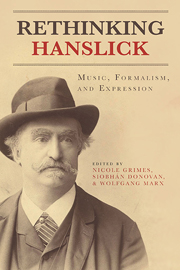Book contents
- Frontmatter
- Contents
- Foreword by Mark Evan Bonds
- Acknowledgments
- Abbreviations
- Chronology
- Introduction
- Part One Rules of Engagement
- Part Two Liberalism and Societal Order
- Part Three Memoirs and Meaning in Social Contexts
- Part Four Critical Battlefields
- 12 Hanslick and Hugo Wolf
- 13 Battle Rejoined: Hanslick and the Symphonic Poem in the 1890s
- 14 On “Jewishness” and Genre: Hanslick's Reception of Gustav Mahler
- Selected Bibliography
- List of Contributors
- Index
13 - Battle Rejoined: Hanslick and the Symphonic Poem in the 1890s
from Part Four - Critical Battlefields
Published online by Cambridge University Press: 05 July 2013
- Frontmatter
- Contents
- Foreword by Mark Evan Bonds
- Acknowledgments
- Abbreviations
- Chronology
- Introduction
- Part One Rules of Engagement
- Part Two Liberalism and Societal Order
- Part Three Memoirs and Meaning in Social Contexts
- Part Four Critical Battlefields
- 12 Hanslick and Hugo Wolf
- 13 Battle Rejoined: Hanslick and the Symphonic Poem in the 1890s
- 14 On “Jewishness” and Genre: Hanslick's Reception of Gustav Mahler
- Selected Bibliography
- List of Contributors
- Index
Summary
Antonin Dvorak and Richard Strauss arm in arm—a right queer sight.
—Theodor HelmAs an observer of late nineteenth-century Viennese cultural life, Eduard Hanslick towers above all other journalists and writers who attempted to map the changing face of music in this period. He has been typecast as the archenemy of musical progress, a foe to any who questioned the sacred tenets of “absolute” music, of which he was alleged to be a seminal theorist and tireless propagandist. His championing of Brahms, as guardian of what he considered the legitimate compositional tradition, is as celebrated as his opposition to Liszt, Wagner, and their ilk, is notorious. Even when it was fashionable to point up his short-sightedness in this latter area, Hanslick's critical pronouncements still continued to be invoked, arguably as much for their eloquence and acumen as out of the need to cite a representative view of misguided conservatism. As a result of the disciplinary upheavals which musicology has undergone over the last twenty-five years, Hanslick's star is again in the ascendant; his judgments have been rehabilitated and reopened to scrutiny in tandem with the dismantling of the idea of “musical progress” as an unquestioned article of faith. Reading through his concert reports offers a glimpse into the contested musical politics of the later nineteenth-century Germanic lands, a world in which old certainties were crumbling, with his being one of the few voices to offer a coherent aesthetic picture, albeit one shaped by certain contestable ideological premises.
- Type
- Chapter
- Information
- Rethinking HanslickMusic, Formalism, and Expression, pp. 289 - 310Publisher: Boydell & BrewerPrint publication year: 2013



